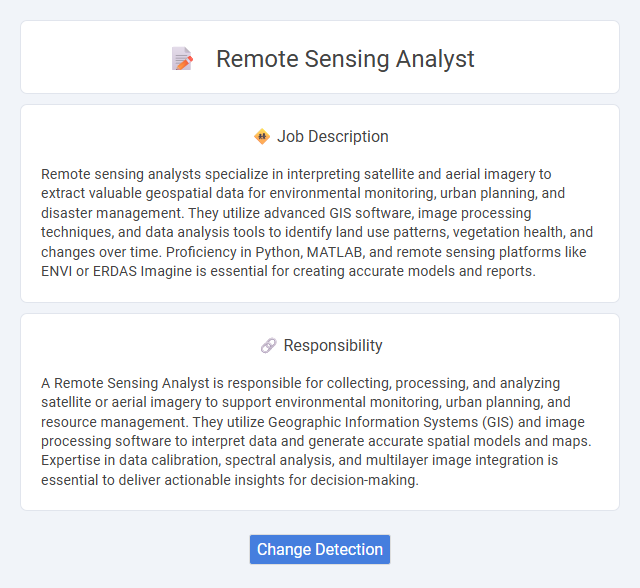
Remote sensing analysts specialize in interpreting satellite and aerial imagery to extract valuable geospatial data for environmental monitoring, urban planning, and disaster management. They utilize advanced GIS software, image processing techniques, and data analysis tools to identify land use patterns, vegetation health, and changes over time. Proficiency in Python, MATLAB, and remote sensing platforms like ENVI or ERDAS Imagine is essential for creating accurate models and reports.
Individuals with strong analytical skills and a keen interest in geographic data are likely to be well-suited for a remote sensing analyst role. Those who can handle detailed data interpretation and are comfortable working with advanced technology and software may find this job fulfilling. Candidates who prefer dynamic problem-solving environments and have patience for meticulous analysis could probably thrive in this position.
Qualification
A Remote Sensing Analyst requires expertise in geographic information systems (GIS), remote sensing technologies, and spatial data analysis. Proficiency in software like ERDAS Imagine, ENVI, and ArcGIS is essential, alongside a strong background in environmental science, geography, or related fields. Advanced skills in data interpretation, image processing, and programming languages such as Python or R enhance job performance and opportunities.
Responsibility
A Remote Sensing Analyst is responsible for collecting, processing, and analyzing satellite or aerial imagery to support environmental monitoring, urban planning, and resource management. They utilize Geographic Information Systems (GIS) and image processing software to interpret data and generate accurate spatial models and maps. Expertise in data calibration, spectral analysis, and multilayer image integration is essential to deliver actionable insights for decision-making.
Benefit
Remote sensing analyst jobs likely offer significant benefits such as access to cutting-edge technology and opportunities to work on environmental monitoring, urban planning, and natural resource management projects. Employees may benefit from strong career growth prospects and the ability to impact critical decision-making through data analysis. The role often provides flexibility in work environments, including remote options, enhancing work-life balance.
Challenge
Remote sensing analyst roles likely involve navigating complex datasets and interpreting multispectral satellite imagery, which can present considerable technical challenges. There is a probability of encountering difficulties in integrating various data sources and ensuring accuracy in environmental or geographical assessments. Managing rapid technological advancements and evolving analytical tools may also require continuous learning and adaptation.
Career Advancement
Remote sensing analyst roles offer significant career advancement opportunities through specialization in geographic information systems (GIS), machine learning, and data interpretation. Professionals often progress to senior analyst, project manager, or spatial data scientist positions by gaining expertise in satellite imagery analysis, environmental monitoring, and geospatial technology. Continuous skill development in programming languages like Python and R, along with certifications in remote sensing software such as ENVI or ERDAS IMAGINE, enhances career growth potential.
Key Terms
Change Detection
Remote sensing analysts specializing in change detection utilize satellite and aerial imagery to monitor and assess environmental and geographical transformations over time. They apply advanced image processing techniques, such as multispectral and hyperspectral analysis, to identify land use changes, deforestation, urban expansion, and natural disaster impacts. Proficiency in GIS software, remote sensing tools, and data interpretation is essential to generate accurate reports supporting environmental management and policy decisions.
 kuljobs.com
kuljobs.com